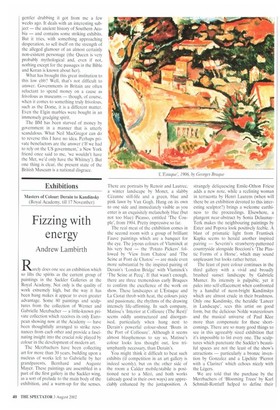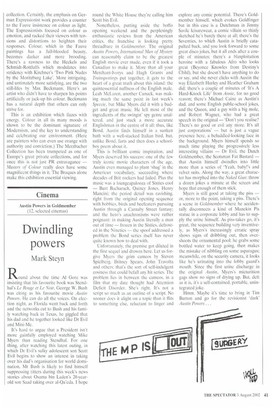Exhibitions
Masters of Colour: Derain to Kandinsky (Royal Academy. till 17 November)
Fizzing with energy
Andrew Lambirth
Rarely does one see an exhibition which so lifts the spirits as the current group of paintings in the Sackler Galleries at the Royal Academy. Not only is the quality of work extremely high, but the way it has been hung makes it appear to even greater advantage. Some 80 paintings and sculptures from the collection of Werner and Gabrielle Merzbacher — a little-known private collection which receives its only European showing now at the Academy — have been thoughtfully arranged to strike resonances from each other and provide a fascinating insight into the crucial role played by colour in the development of modern art.
The Merzbachers have been collecting art for more than 30 years, building upon a nucleus of works left to Gabrielle by her grandparents, Bernhard and Auguste Mayer. These paintings are assembled in a part of the first gallery in the Sackler wing, as a sort of prelude to the main body of the exhibition, and a warm-up for the senses. There are portraits by Renoir and Lautrec, a winter landscape by Monet, a slabby Cezanne still-life and a green, blue and pink lawn by Van Gogh. Hung on its own to one side and immediately visible as you enter is an exquisitely melancholy blue (but not too blue) Picasso, entitled 'The Couple', from 1904. Pretty impressive so far.
The real meat of the exhibition comes in the second room with a group of brilliant Fauve paintings which are a banquet for the eye. The joyous colours of Vlaminck at his very best — the 'Potato Pickers' followed by 'View from Chatou' and 'The Seine at Pont de Chatou' — are made even more substantial by the inspired pairing of Derain's 'London Bridge' with Vlaminck's 'The Seine at Pecq'. If that wasn't enough, there are three tremendous early Braques to confirm the excellence of the work on show. These landscapes at L'Estaque and La Ciotat throb with heat, the colours juicy and passionate, the rhythms of the drawing intensely life-affirming. In such company, Matisse's 'Interior at Collioure (The Rest)' seems oddly unstructured and disorganised, particularly when hung next to Derain's powerful colour-shout 'Boats in the Port of Collioure'. Although it seems almost blasphemous to say so, Matisse's colour looks less thought out, less triumphantly necessary, than Derain's.
You might think it difficult to beat such exhibits (if competition in an art gallery is indeed seemly), but on the other side of the room a Calder mobile/stabile is positioned next to a Miro, and both works (already good in their own ways) are appreciably enhanced by the juxtaposition. A
strangely deliquescing Emile-Othon Friesz adds a new note, while a reclining woman in terracotta by Henri Laurens (when will there be an exhibition devoted to this interesting sculptor?) brings a welcome earthiness to the proceedings. Elsewhere, a plangent near-abstract by Sonia DelaunayTerk makes the neighbouring paintings by Exter and Popova look positively feeble. A blast of prismatic light from Frantisek Kupka seems to herald another inspired pairing — Severini's strawberry-patterned countryside alongside Boccioni's 'The Plastic Forms of a Horse', which may sound unpleasant but looks rather better.
The feast of pure colour continues in the third gallery with a vivid and broadly brushed sunset landscape by Gabriele Munter. Its intensity is palpable, yet it pales into self-effacement when confronted by a handful of neon-bright Kandinskys which are almost crude in their brashness. Only one Kandinsky, the heraldic 'Lancer in Landscape', sees this artist on good form, but the delicious Nolde watercolours and the musical universe of Paul Klee more than compensate for these shortcomings. There are so many good things to see in this agreeably sized exhibition that it's impossible to list every one. The sculptures which punctuate the Sackler's beautiful spaces are not the least of the show's attractions — particularly a bronze invention by Gonzalez and a Lipchitz `Pierrot with a Clarinet' which echoes nicely with the Legers.
We are told that the purchase by the Merzbachers of 'Blooming Trees' by Karl Schmidt-Rottluff helped to define their collection. Certainly, the emphasis on German Expressionist work provides a counter to the Fauve insistence on colour as light. The Expressionists focused on colour as emotion, and racked their viewers with tensions and distortions to heighten their responses. Colour, which in the Fauve paintings has a full-blooded beauty, becomes darker and more brooding. There's a rawness to the Heckels and Schmidt-Rottluffs which modulates into stridency with Kirchner's 'Two Pink Nudes by the Moritzburg Lake', More intriguing, and untimately more satisfying, are the two still-lifes by Max Beckmann. Here's an artist who didn't have to sharpen his points artificially or jack-up his colour. Beckmann has a natural depth that others can only strive for.
This is an exhibition which fizzes with energy. Colour in all its many moods is shown to be the dominant signature of Modernism, and the key to understanding and celebrating our environment, (Here are painters who can even use orange with authority and conviction.) The Merzbacher Collection has been trumpeted as one of Europe's great private collections, and for once this is not just PR extravagance — Masters of Colour really does have some magnificent things in it. The Braques alone make this exhibition essential viewing.



























































 Previous page
Previous page